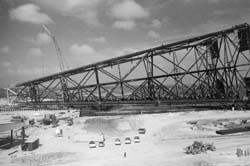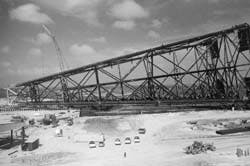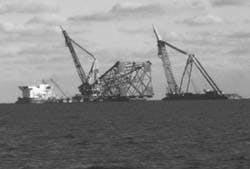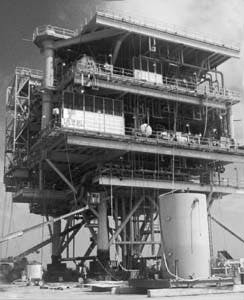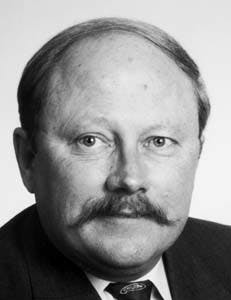TECHNOLOGY Deepwater fixed platforms now aimed at future optimization
Scott D. Powers, Sandeep Khurana
Petro-Marine Engineering of Texas Inc.
Houston
Deepwater fixed platforms should be designed with the potential to use these platforms for gathering production from other and remote sources when the pipelines serving the platforms are no longer fully utilized.
This optimization typically involves attracting special production processing and transportation agreements that require making changes during the detailed design stage of the platform.
Severe time constraints pose significant challenges during a fast-track project. But because of the overall economic incentives to make changes and with the right project management and technical expertise, these challenges can be met.
!-- figure one (photo) --
The Viosca Knoll No. 817A jacket is shown during fabrication. This jacket was designed to be launched from a barge (Fig. 1).
Fast tracks
In the offshore oil and gas industry, there is an ever-increasing pressure to compress the schedule from "idea to barrel." As recently as a couple of years ago, fast-tracking offshore projects became the main challenge for operators and contractors. However, after achieving this goal, the emphasis has now shifted to optimizing the various interfaces in the fast-track.
Economics justify fast-track strategies for fixed deepwater platform developments. The goal is to minimize the time between capital expenditures for facilities and the start of production.
Past experience on similar projects, available computer technology, and newly developed integrated design and project management software applications make fast-track schedules possible and economical. Also, early involvement by fabricators, installers, and the lease operator can help maintain the schedule and minimize overall project cost.
For deepwater fixed platforms the fast-tracking of engineering, fabrication, and installation should be interfaced with prospects for using these platforms as gathering and processing platforms.
Two recently installed Gulf of Mexico platforms, Viosca Knoll 817A (VK 817A) in 671 ft of water and Garden Banks 72A (GB 72A) in 514 ft of water, are examples of this approach.
VK 817A was completed in 15 months from the start of design to offshore installation in August 1995. GB 72A was completed in 10 months and installed in November 1995.
Because of their location, these facilities attracted previously uneconomic prospects in adjacent blocks. The economic incentives to process the production from these adjacent prospects justify the design changes incurred during execution of the project.
Handling design changes in a fast-track environment poses new challenges. Sensitivity studies are required to quickly address technical options. Effective, predictive project management tools are essential to identify changes in the project critical path.
Typically, for deepwater fixed platforms, the structural design and jacket fabrication are on the critical path. Previous experience from platforms designed for similar water depths allows for accelerating the structural work schedule.
The production facilities' design and equipment fabrication also become critical. The schedule for the deck fabrication and production equipment installation must be compatible with the jacket installation schedule. Installation costs are far less if the jacket and deck are installed in one mobilization.
Project economics
A discounted cash flow analysis is suitable for evaluating project economics. The analysis includes estimating the timing and amount of all projected capital and operating expenditures and related revenues. The discounted cash flow rate of return (Dcfror) is an economic performance indicator based on this analysis.
Generally, the financial acceptability of a capital investment is determined by calculating the net present value (NPV) within an acceptable guideline range (discount rate) for the various alternatives available. The selected alternative is the one with the greatest NPV.
Another economic indicator is payout. Payout is the time required, after project investment is substantially complete, for the positive net cash flow to equal the initial cost.
Table 1 [60491 bytes] shows the before tax analysis for an 80 MMscfd/3,000 bo/d offshore oil and gas production facility in 671 ft of water. The analysis compares the project, over a 20-year life, assuming a "standard" 18-month design and fabrication schedule compared to a 15-month, "fast-track" schedule.
The numbers shown are intended to illustrate the relative value between cases and are not necessarily the actual costs of the projects.
Cases 1 and 2 show the financial indicators for the project using a standard and fast-track schedule, respectively. Case 3 depicts how much additional capital can be invested in Case 2 to yield comparable Case 1 economics.
Cases 4 and 5 show the effect on economics of producing an additional 2,000 bo/d for a $0.50/bbl processing fee. Case 6 shows how much additional capital can be invested in Case 5 to yield comparable Case 4 economics.
Cases 7 and 8 show the effect on economics of compressing 250 MMscfd gas for a $0.10/Mscf fee when operating as a junction platform. Case 9 depicts how much additional capital can be invested in Case 8 to yield comparable Case 7 economics.
The estimated timing and amount of all projected capital and operating expenditures and related revenues for Cases 1 and 2 are in Table 2. [41753 bytes] All subsequent cases described were analyzed using the same technique.
The fast-track schedule, Case 2, shows that by beginning production 3 months earlier, the net present value of the project increases by $9.47 million. For a 15% discount rate, the discounted cash flow rate of return (Dcfror) increases 12.2%, and the payout period decreases by 10.7%.
Case 3 shows that an additional $10.89 million in capital investment in the fast-track project yields economics comparable to the standard schedule project.
One conclusion derived from this analysis is that considerable incentive money is available as an inducement to equipment suppliers and fabricators to accelerate the project schedule of any critical equipment items to maintain the fast-track schedule. The downside conclusion is that delays in the fast-track schedule caused by suppliers and fabricators failing to meet critical deliveries has an opposite but equal negative impact on project economics.
Past experience indicates bonus clauses motivate competent suppliers, although they rarely miss scheduled deadlines. However, penalty clauses of the required magnitude to compensate for the losses described above are not practical. Dealing with familiar contractors, with proven track records, should be a prime consideration for all critical-path equipment items.
Deepwater installations can typically attract marginal discoveries located in adjacent blocks. Cases 4-6 show the effect of a production processing agreement on project economics. The economic analysis demonstrates that additional processing capacity and operational flexibility incorporated during detailed design can help defray the initial development costs.
!-- figure 4 photo --
Two cranes were required to lift the Garden Banks 72A jacket (Fig. 4).
Comparing Case 4 to Case 1 or Case 5 to Case 2 reveals that the project's net present value (15% discount rate) is increased by about $2 million when 2,000 bo/d are processed for a $0.50/bbl charge. A comparison of Case 1 to Case 5 shows an $11 million increase in the NPV when comparing the standard schedule project with no processing with the fast-track schedule with a production processing agreement.
Deepwater installations near existing pipelines or adjacent production facilities can typically attract transportation agreements for moving production through the system.
Cases 7-9 show the effect on project economics of a transportation agreement. The economic analysis demonstrates that additional compression capacity and operational flexibility incorporated during detailed design can help defray the initial development cost. Comparing Case 7 to Case 1 or Case 8 to Case 2 reveals that the project's NPV (15% discount rate) is increased by about $24 million when 250 MMscfd are compressed for a $0.10/Mscf charge.
A comparison of Case 1 to Case 8 shows a $33 million increase in the NPV when comparing the standard schedule project with no processing or transportation agreement with the fast-track schedule with a production processing and transportation agreement.
Project management
The previous economic analyses justify incentive payments to expedite critical path items. Contingency money should be budgeted for this purpose. Requests to management for additional funds, in this situation, are not recommended for the faint hearted. Communication of these special needs early in project will help mitigate management concerns.
Special managerial and technical expertise is required to ensure that the schedule is preserved. A fast-track schedule environment amplifies the normal challenges of deepwater development projects. Because both structural and facilities equipment fabrication are on the critical path, their progress must be closely monitored.
!-- figure 5 photo --
The deck for the Viosca Knoll No. 817A jacket is typical for a platform designed for 80 MMscfd/3,000 bo/d in 671 ft of water (Fig. 5).
Communication among all project members must be streamlined to ensure information is disseminated quickly. A local-area computer network makes this task much easier. File sharing provides all project team members access to critical project information.
Also, electronic project bulletin boards can allow all team members instant access to information and changes immediately when changes arise. This bulletin board system should be maintained "evergreen." By allowing customers and contractors to freely input into the system, one can eliminate the need for a detailed document distribution matrix. All project members are responsible for staying in the "loop."
The bulletin board also serves as a punch list for ongoing action items printed in hard-copy form and included in weekly status reporting.
Because of special production processing and transportation agreements, changes during detailed design are inevitable. One needs to plan early on how these design changes will be handled and on how they will affect the overall schedule.
Another consideration is to be prepared to undertake sensitivity studies and to respond quickly to the various options as they arise.
On the platform, ample deck space should be provided at the outset because additional facilities equipment required to accommodate production processing and transportation agreements can require considerable space.
Design considerations
On previous deepwater development projects, such as Kilauea (1989) in 620 ft of water and Tick (1990) in 720 ft water depth, jacket design, fabrication, and installation were the critical path schedule items. Today, to avoid delays, it is possible to begin detailed design with initial design criteria assumptions based on past experience.
Today's fast-track design environment tends to compress the jacket design, bid, and award of fabrication schedules. Now, facilities equipment may also be on the project critical path.
The main challenge in a fast-track development project is handling design criteria changes caused by delays in the availability of critical data. Changes affecting both structural design and facilities equipment fabrication can affect the overall project schedule. Changes to the initial design criteria can have serious consequences regarding long-lead materials.
To start detailed structural design, total topside weights must be estimated and a jacket configuration selected. In general, the goal in developing the jacket configuration is to minimize the overall cost of design, fabrication, and installation.
Maximum lift capacity offshore and installation costs usually govern whether the jacket is designed for lift or launch. The jacket, in Fig. 1, is designed with launch runners for use during installation. These can clearly be seen in Fig. 2. [71649 bytes]
This jacket's weight for launch is 8,300 tons and it cost $14 million to fabricate. The piles weigh 1,540 tons and cost $1.5 million. Offshore jacket installation cost $6 million.
Fig. 3 [67075 bytes] shows the smaller jacket, for 514 ft of water depth, that is designed to be lifted instead of launched. Lifting was cost-effective because it saved fabrication cost by eliminating the launch truss. However , it required mobilization of two derrick barges to lift this relatively heavy, 4,950-ton jacket (Fig. 4).
The jacket cost $9 million to fabricate. The piles weigh 1,150 tons and cost $1 million. But offshore jacket installation cost is about $5 million.
Once the jacket configuration is established, a similar existing platform design can be identified and selected, and with limited computer modeling and analyses it can be adjusted to the required water depth.
Long lead items such as main steel are sufficiently defined to permit orders to be placed. Fabrication bid packages and specifications are developed with input from vendors. This is done to involve the fabricator and/or installer at the early stages of the project.
Detailed design continues while the fabricator/installer provides input concerning constructability and availability of the required machinery.
A critical facilities equipment item in the fast-track schedule is the sales-gas meter skid and associated risers. The review cycle times for these items can be quite lengthy and the design requires close liaison with the pipeline operator to establish the equipment and operating requirements and preferences.
Special pigging requirements such as "intelligent pigs" will require significantly longer launchers/receivers and more deck space than conventional pigging systems.
In general, facility equipment packages must be sized quickly and the equipment arrangement must be determined before the deck size and deck detailed design can begin. Fig. 5 shows a typical deck for an 80 MMscfd/3,000 bo/d platform in 671 ft of water. Note the large subcellar deck for pipeline equipment for junction platform service.
An additional consideration for deck design is identifying the drilling rig size, type, and configuration. The lease operator can usually provide drilling requirements, and most drilling contractors will provide rig layouts and loads to meet typical design requirements. The space and weight envelope should permit the use of a number of different drilling rigs.
If one anticipates transportation agreements, space on the top deck should be provided to accommodate large turbine-driven compressors. These compressors have considerable weight.
Good relationships with equipment suppliers are critical to completing fast-track projects. Review and approval cycles for equipment drawings and data must be monitored closely if the schedule is to be preserved.
Source inspectors must identify problem areas quickly during fabrication; otherwise, delays will be encountered. Additional time may be required during hookup of the equipment onshore to correct deficiencies not discovered during initial equipment fabrication.
Finally, operations input, early in the design cycle, will eliminate untimely changes that tend to occur late in the design phase. Late design changes can adversely affect the project schedule, and the cost of making changes late in the design are significantly higher.
The big picture, from an economic viewpoint, is that significant capital should be available to address design changes to keep the project on schedule.
Fabrication, installation
Equipment installation on each deck level, in a fast-track environment, requires efficient equipment, manpower, and materials handling. Efficiency is increased when most work on each deck level can be done at ground level.
Equipment delivery schedules are established so that equipment can be set on the deck at ground level. Most of the piping is also installed in the racks while each deck section is at ground level. After the decks are stacked, very little hookup work is required off the ground. Equipment deliveries to the deck are critical in this situation.
Early involvement of the fabricator during detailed design is critical. Their input regarding the constructability of the equipment is valuable during detailed design.
Timing of jacket and deck/equipment fabrication is critical. These schedules must be compatible if offshore installation is to occur with one mobilization. Considerable cost is added to the installation if an additional mobilization is required to set the deck offshore.
Early involvement of the installation contractors is essential for successful completion of the offshore work. The contractors are the best source for information on overall equipment availability for scheduling the installation program.
Domestic equipment availability can be highly variable during times when international projects are competing for the equipment. The most successful designs are those which can be fabricated and installed with the broadest range of equipment. Special equipment requirements necessary for installation translate into higher costs and potential schedule conflicts because of availability.
Bibliography
Khurana, S., 1995, "Deepwater platform designed on fast track schedule," OGJ, Apr. 17, 1995, pp. 55-57.
The Authors
Powers
Scott D. Powers is vice-president of engineering for Petro-Marine Engineering of Texas Inc., Houston. He directs all engineering, design, and purchasing efforts and has over 15 years' experience in the energy industry, including onshore, domestic, and international projects. Powers has a BS in chemical engineering from the University of Oklahoma. He is a registered professional engineer in Texas.
Khurana
Sandeep Khurana is a senior engineer with Petro-Marine Engineering of Texas Inc., Houston. For the past 7 years, he has been involved in the conceptual and detailed design and other research-related areas concerning deepwater platforms. Khurana has an MS in civil engineering from Rice University. He is a registered professional engineer in Texas.
Copyright 1996 Oil & Gas Journal. All Rights Reserved.
